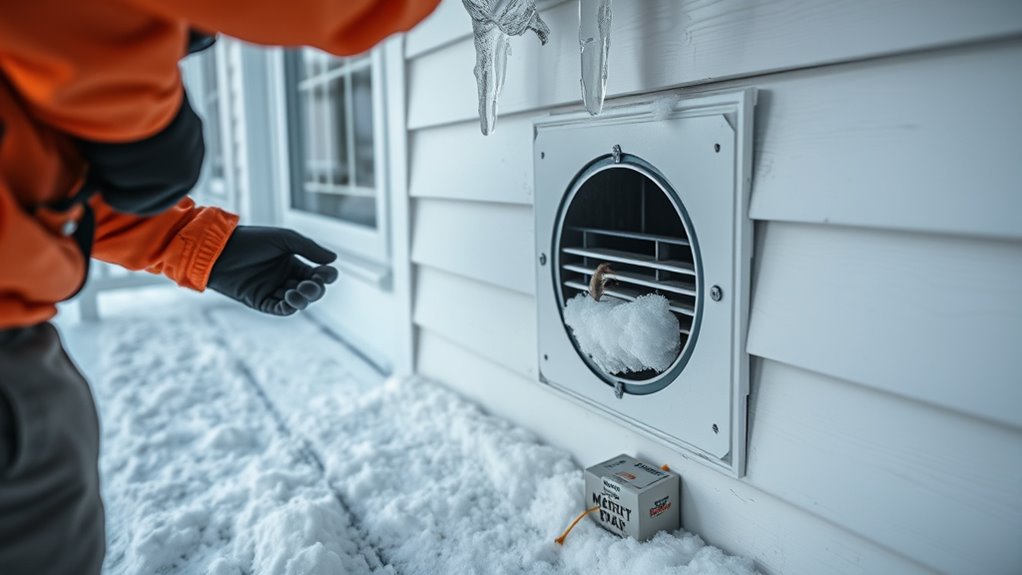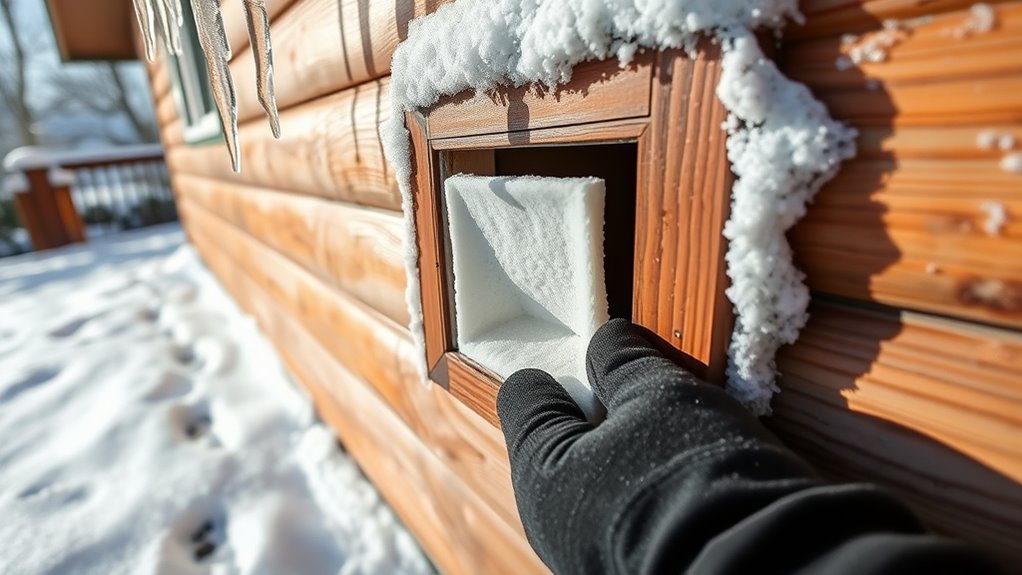During winter, pests seek warmth and shelter indoors, so it’s vital to seal entry points around windows, doors, and pipes using caulk or weather stripping. Keep food stored airtight, remove clutter, and set traps to monitor any activity. Trim tree branches away from your home and clear snow around the foundation to deter pests from sneaking inside. Following these steps can help protect your home—learn more tips to stay critter-free all season.
Key Takeaways
- Seal all potential entry points around windows, doors, pipes, and vents to prevent pests from entering your home.
- Store food in airtight containers and eliminate crumbs to reduce attraction for rodents and critters.
- Regularly inspect hidden areas like attics and basements for signs of pest activity and set traps as needed.
- Keep outdoor areas clear of snow, ice, and overhanging branches to block pest access points.
- Maintain home maintenance and cleanliness to minimize hiding spots and deter winter infestations.

Have you ever wondered why pests seem to invade your home more during winter? As temperatures drop outside, rodents and other critters seek warm, cozy places to escape the cold. This seasonal shift compels pests to move indoors, making winter a prime time for infestations. To keep these unwelcome guests at bay, you need to focus on indoor rodent prevention and seasonal pest monitoring. These strategies help you identify vulnerabilities in your home and catch pest activity early, before it becomes a full-blown problem.
Indoor rodent prevention starts with sealing entry points. Take a walk around your home and inspect for gaps around windows, doors, utility pipes, and vents. Mice and rats can squeeze through tiny openings, so use caulk, steel wool, or weather stripping to block their access. Don’t forget to check the basement, attic, and garage—common spots where rodents can slip in unnoticed. Keeping your home tidy also plays a role; store food in airtight containers and clean up crumbs or spills promptly. Cluttered areas provide hiding spots and nesting materials, so declutter regularly to make your home less inviting.
Seal gaps and keep your home tidy to prevent rodent entry and nesting.
Seasonal pest monitoring is equally important during winter. Regularly check for signs of pests, such as droppings, gnaw marks, or nesting materials, especially in seldom-used areas like storage rooms or attics. Set up traps or bait stations if you notice activity, and handle these with care to avoid contact. Monitoring not only alerts you to early infestations but also helps you gauge the effectiveness of your prevention efforts. During winter, pests are less active outside, but they’re often just waiting for the warmest spots inside. Staying vigilant with seasonal pest monitoring ensures you catch problems early, saving you time, money, and stress later on.
Additionally, maintaining a cold outdoor environment can help reduce pest populations around your home. Keep snow and ice cleared from walkways and around your foundation, and trim back tree branches that touch your home, preventing easy access. Installing door sweeps and weather stripping can also help maintain a barrier against pests trying to sneak in through gaps. Remember, winter pest control isn’t just about reacting to pests; it’s about proactive prevention. Consistently applying these practices can make your home less attractive to pests and keep your space critter-free throughout the season. By combining indoor rodent prevention with diligent seasonal pest monitoring, you’re taking smart steps to protect your home when pests are most eager to invade.
Furthermore, understanding self-watering plant pots can help you maintain healthy indoor plants during the winter months, reducing clutter and potential hiding spots for pests.
Frequently Asked Questions
How Do I Identify Pest Entry Points During Winter?
To identify pest entry points during winter, start with an entry point inspection around your home’s foundation, windows, and doors. Look for winter pest signs like droppings, chewed wires, or nests in hidden areas. Pay close attention to gaps, cracks, or holes, especially where utilities enter. Seal any openings you find to prevent critters from sneaking inside, ensuring your home stays critter-free all season long.
Are DIY Pest Control Methods Effective in Winter?
DIY pest control methods can be somewhat effective for winter pest control, especially for minor issues like sealing cracks or removing food sources. However, their effectiveness is limited against larger infestations or stubborn pests. You should consider professional services if DIY efforts don’t work, as experts can identify hidden entry points and apply targeted treatments. For best results, combine DIY strategies with professional pest control to keep your home critter-free all winter long.
What Are the Signs of a Winter Pest Infestation?
If you’re spotting tiny droppings, torn insulation, or scraps of food, congratulations—winter mice have moved in! Bug droppings, gnawed wires, and mysterious squeaks are dead giveaways. You might also notice strange odors or little footprints in the snow near your home. These signs scream that pests are cozying up for winter, so don’t ignore them—your home’s critter-free status depends on catching these signals early!
When Is the Best Time for Professional Winter Pest Treatment?
The best time for professional winter pest treatment is early fall or late autumn. During this period, pests seek shelter indoors as seasonal pest behavior changes. Acting now allows you to implement pest prevention tips before infestations become severe. Getting ahead of pests guarantees your home stays critter-free throughout winter. Schedule a professional treatment now to effectively target hiding pests and protect your home from winter invaders.
How Can I Prevent Pests From Entering Through Vents and Chimneys?
Think of your vents and chimneys as open gates inviting unwelcome guests. To block pests, install sturdy vent covers and chimney caps, creating a fortress around these entry points. Regularly inspect and repair any gaps or holes. Keep the area clean and free of debris that might attract critters. With these defenses in place, you’ll stop pests from sneaking inside and turning your home into their winter haven.
Conclusion
By taking these simple winter pest control steps, you’ll turn your home into an impenetrable fortress, preventing critters from turning your cozy haven into a wild jungle. Imagine mice and insects bouncing off your sealed doors and sturdy screens, never daring to invade your space again. With just a little effort, you’ll keep pests out so effectively that even the most daring critters will think twice before approaching. Protect your home now and enjoy a pest-free winter like never before!










